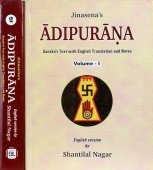Dharmashastra, Dharma-shastra, Dharmaśāstra, Dharmaśāstrā: 19 definitions
Introduction:
Dharmashastra means something in Hinduism, Sanskrit, the history of ancient India, Marathi. If you want to know the exact meaning, history, etymology or English translation of this term then check out the descriptions on this page. Add your comment or reference to a book if you want to contribute to this summary article.
The Sanskrit terms Dharmaśāstra and Dharmaśāstrā can be transliterated into English as Dharmasastra or Dharmashastra, using the IAST transliteration scheme (?).
In Hinduism
Purana and Itihasa (epic history)
Source: Cologne Digital Sanskrit Dictionaries: The Purana IndexDharmaśāstrā (धर्मशास्त्रा).—A Vidyā; Law books to be learnt by a Prince;1 known to Sūta;2 learnt by Kṛṣṇa and Rāma;3 refer to three tanus, Prājāpatyā, Raudrā and Vaiṣṇavī;4 said to be Purātana or ancient.5
- 1) Matsya-purāṇa 53. 6; 215. 24; 220. 2; 225. 2 and 4. Viṣṇu-purāṇa III. 6. 27.
- 2) Bhāgavata-purāṇa I. 1. 6.
- 3) Ib. X. 45. 34.
- 4) Brahmāṇḍa-purāṇa II. 33. 31; 35. 88; III. 3. 88; 19. 23.
- 5) Vāyu-purāṇa 61. 78; 66. 109; 83. 53.

The Purana (पुराण, purāṇas) refers to Sanskrit literature preserving ancient India’s vast cultural history, including historical legends, religious ceremonies, various arts and sciences. The eighteen mahapuranas total over 400,000 shlokas (metrical couplets) and date to at least several centuries BCE.
Dharmashastra (religious law)
Source: Knowledge Traditions & Practices of India: Education: Systems & PracticesDharmaśāstra (धर्मशास्त्र, “sociology”) refers to one of the nine divisions of the Paurūṣeya classification of Śāstra knowledge; all part of the ancient Indian education system, which aimed at both the inner and the outer dimension of a person.
Source: Shodhganga: The saurapurana - a critical study (dharma)Dharmaśāstra (धर्मशास्त्र) refers to the “codes of Hindu rites and customs” as mentioned in the 10th century Saurapurāṇa: one of the various Upapurāṇas depicting Śaivism.—The Saurapurāṇa contains a good number of chapters on dharmaśāstra—topics which are mainly religious. These topics are varṇāśrama-dharma, the duties of the twice-born, ācāra, dāna, śrāddha, praāaścitta, ahiṃsā etc.—The Purāṇas accept the authority of the Vedas and all dharmaśāstras are also rooted in the Vedas. The Saurapurāṇa admits the authority of the Vedas. They are adored by the people. The Brāhmaṇas perform karma on the basis of the Vedas. It is stated that if some body does any karma surpassing the Vedas, his karma becomes futile.

Dharmashastra (धर्मशास्त्र, dharmaśāstra) contains the instructions (shastra) regarding religious conduct of livelihood (dharma), ceremonies, jurisprudence (study of law) and more. It is categorized as smriti, an important and authoritative selection of books dealing with the Hindu lifestyle.
Arthashastra (politics and welfare)
Source: Knowledge Traditions & Practices of India: Indian Ethics: Individual and SocialDharmaśāstra (धर्मशास्त्र).—The importance of ethics and ethical values (nītiśāstra) is highlighted in epics and philosophical texts like, Upaniṣads, Rāmāyaṇa, Darśana-śāstras and Dharma-śāstras. In the dharmaśāstras, emphasis is on the social ethics. In these texts the inter-personal and social relations are placed in an ethical framework for guidance. In these texts the ethical problems are discussed in an indirect manner.

Arthashastra (अर्थशास्त्र, arthaśāstra) literature concerns itself with the teachings (shastra) of economic prosperity (artha) statecraft, politics and military tactics. The term arthashastra refers to both the name of these scientific teachings, as well as the name of a Sanskrit work included in such literature. This book was written (3rd century BCE) by by Kautilya, who flourished in the 4th century BCE.
General definition (in Hinduism)
Source: WikiPedia: HinduismDharmaśāstra is a genre of Sanskrit texts and refers to the śāstra, or Indic branch of learning, pertaining to Hindu dharma, religious and legal duty. The voluminous textual corpus of Dharmaśāstra is primarily a product of the Brāhmaṇical tradition in India and represents the elaborate scholastic system of an expert tradition. Because of its sophisticated jurisprudence, Dharmaśāstra was taken by early British colonial administrators to be the law of the land for Hindus in India.
Source: Institute of Sri Ramchandra Consciousness: A Handbook of Hindu Religion: LiteratureDharmaśāstra (धर्मशास्त्र):—They are of two categories, the Sūtras and the Smṛtis. The Sūtras, as their name indicates, are in the form of aphorisms and the Smṛtis are in metrical form. If śruti is what is directly revealed to the Ṛṣis, the Smṛti is what is recollected by them and recorded afterwards. The Dharmaśāstras give the code of conduct applicable to each section of society and to the whole society in common. All that is contained in the Dharmaśāstras is said to be taken from the Vedas which teach fundamental ethical truths and they claim to teach nothing new. If there is any explicit contradiction between what is laid down in the Vedas and what is taught in the Dharmaśāstras, the former are to be followed in preference to thelatter, as they are absolutely and universally true
India history and geography
Source: Cologne Digital Sanskrit Dictionaries: Indian Epigraphical GlossaryDharma-śāstra.—(BL), scriptures. Note: dharma-śāstra is defined in the “Indian epigraphical glossary” as it can be found on ancient inscriptions commonly written in Sanskrit, Prakrit or Dravidian languages.

The history of India traces the identification of countries, villages, towns and other regions of India, as well as mythology, zoology, royal dynasties, rulers, tribes, local festivities and traditions and regional languages. Ancient India enjoyed religious freedom and encourages the path of Dharma, a concept common to Buddhism, Hinduism, and Jainism.
Languages of India and abroad
Marathi-English dictionary
Source: DDSA: The Molesworth Marathi and English Dictionarydharmaśāstra (धर्मशास्त्र).—n (S) The code or body of Hindu law; the laws and institutes of manu &c. 2 A code of laws gen. 3 The science, system, or law of piety and religion.
Source: DDSA: The Aryabhusan school dictionary, Marathi-Englishdharmaśāstra (धर्मशास्त्र).—n The code or body of Hindu law.
Marathi is an Indo-European language having over 70 million native speakers people in (predominantly) Maharashtra India. Marathi, like many other Indo-Aryan languages, evolved from early forms of Prakrit, which itself is a subset of Sanskrit, one of the most ancient languages of the world.
Sanskrit dictionary
Source: DDSA: The practical Sanskrit-English dictionaryDharmaśāstra (धर्मशास्त्र).—a code of laws, jurisprudence; न धर्मशास्त्रं पठतीति कारणम् (na dharmaśāstraṃ paṭhatīti kāraṇam) H.1.17; Y.1.5. [मनुर्यमो वसिष्ठोऽत्रिः दक्षो विष्णुस्तथाङ्गिराः । उशना वाक्पतिर्व्यास आपस्तम्बोऽ थ गौतमः ॥ कात्यायनो नारदश्च याज्ञवल्क्यः पराशरः । संवर्तश्चैव शङ्खश्च हारीतो लिखितस्तथा ॥ एतैर्यानि प्रणीतानि धर्मशास्त्राणि वै पुरा । तान्येवातिप्रमाणानि न हन्तव्यानि हेतुभिः (manuryamo vasiṣṭho'triḥ dakṣo viṣṇustathāṅgirāḥ | uśanā vākpatirvyāsa āpastambo' tha gautamaḥ || kātyāyano nāradaśca yājñavalkyaḥ parāśaraḥ | saṃvartaścaiva śaṅkhaśca hārīto likhitastathā || etairyāni praṇītāni dharmaśāstrāṇi vai purā | tānyevātipramāṇāni na hantavyāni hetubhiḥ) ||]
Derivable forms: dharmaśāstram (धर्मशास्त्रम्).
Dharmaśāstra is a Sanskrit compound consisting of the terms dharma and śāstra (शास्त्र). See also (synonyms): dharmaśāsana.
Source: Cologne Digital Sanskrit Dictionaries: Shabda-Sagara Sanskrit-English DictionaryDharmaśāstra (धर्मशास्त्र).—n.
(-straṃ) 1. The body or code of Hindu law. 2. Any work on the subject. E. dharma virtue, and śāstra a treatise. śiṣyate anena śāsa karaṇe ṣṭran . 6 ta0 sa0 .
Source: Cologne Digital Sanskrit Dictionaries: Benfey Sanskrit-English DictionaryDharmaśāstra (धर्मशास्त्र).—n. 1. a book treating of duty, [Hitopadeśa] 19, 8, M. M. 2. the body of law, [Mānavadharmaśāstra] title, 2, 10.
Dharmaśāstra is a Sanskrit compound consisting of the terms dharma and śāstra (शास्त्र).
Source: Cologne Digital Sanskrit Dictionaries: Cappeller Sanskrit-English DictionaryDharmaśāstra (धर्मशास्त्र).—[neuter] a law-book.
Source: Cologne Digital Sanskrit Dictionaries: Aufrecht Catalogus CatalogorumDharmaśāstra (धर्मशास्त्र) as mentioned in Aufrecht’s Catalogus Catalogorum:—a revision of the Vīramitrodaya, compiled for Colebrooke in 1800 by Bālaśarman Pāyaguṇḍe and his pupil Manudeva. Io. 37.
Source: Cologne Digital Sanskrit Dictionaries: Monier-Williams Sanskrit-English DictionaryDharmaśāstra (धर्मशास्त्र):—[=dharma-śāstra] [from dharma > dhara] n. idem
Source: Cologne Digital Sanskrit Dictionaries: Yates Sanskrit-English DictionaryDharmaśāstra (धर्मशास्त्र):—[dharma-śāstra] (straṃ) 1. n. A code of laws.
[Sanskrit to German]
Sanskrit, also spelled संस्कृतम् (saṃskṛtam), is an ancient language of India commonly seen as the grandmother of the Indo-European language family (even English!). Closely allied with Prakrit and Pali, Sanskrit is more exhaustive in both grammar and terms and has the most extensive collection of literature in the world, greatly surpassing its sister-languages Greek and Latin.
Kannada-English dictionary
Source: Alar: Kannada-English corpusDharmaśāstra (ಧರ್ಮಶಾಸ್ತ್ರ):—[noun] any of the sacred texts consisting of laws, customs and ethics of the Hindus.
Kannada is a Dravidian language (as opposed to the Indo-European language family) mainly spoken in the southwestern region of India.
See also (Relevant definitions)
Partial matches: Shastra, Dharma, Tarma.
Starts with: Dharmashastradipika, Dharmashastrajna, Dharmashastrakarika, Dharmashastranibandha, Dharmashastraruci, Dharmashastrasamgraha, Dharmashastrasamgrahashloka, Dharmashastrasarvasva, Dharmashastrasudhanidhi, Dharmashastravacana.
Ends with: Ashvamedhikadharmashastra, Chalariyadharmashastra, Gautamadharmashastra, Haritadharmashastra, Manava-Dharmashastra, Mulabhidharmashastra, Nagarjuniyadharmashastra, Nagarjunoyadharmashastra, Parasharadharmashastra, Ritudharmashastra, Samskaradidharmashastra, Samyuktabhidharmashastra, Shariradharmashastra, Tattvamritadharmashastra, Vasishthadharmashastra, Yajnavalkyadharmashastra.
Full-text (+2307): Smriti, Bandhanika, Aviprayukta, Alubdha, Punarupasadana, Agnihavana, Avasphotana, Pratidvadashan, Purushagati, Garbhamasa, Aikaratrika, Gurubharya, Kalabhara, Gurudarshana, Kilasin, Brahmadeyanusamtana, Udakakriya, Padopasamgrahana, Avaidya, Abhunjana.
Relevant text
Search found 117 books and stories containing Dharmashastra, Dharma-śāstra, Dharma-sastra, Dharma-śastra, Dharma-shastra, Dharmaśāstra, Dharmaśāstrā, Dharmasastra, Dharmaśastra; (plurals include: Dharmashastras, śāstras, sastras, śastras, shastras, Dharmaśāstras, Dharmaśāstrās, Dharmasastras, Dharmaśastras). You can also click to the full overview containing English textual excerpts. Below are direct links for the most relevant articles:
Yajnavalkya-smriti (Vyavaharadhyaya)—Critical study (by Kalita Nabanita)
Chapter 1.1a - Meaning of the Term smṛti < [Chapter 1 - Introduction]
Chapter 1.1d - The Extensive Smṛti Literature < [Chapter 1 - Introduction]
Chapter 4.2 - Supreme Judicial Mechanism < [Chapter 4 - The Political Aspect Reflected in the Vyavahārādhyāya]
The Gita’s Ethics (A Critical Study) (by Arpita Chakraborty)
8. Dharma Sutras and Dharma Shastras < [Chapter 1 - Indian Ethics]
2. An analysis of Indian ethics in general reveals certain features < [Chapter 1 - Indian Ethics]
3. Elements of Sadharana Dharma < [Chapter 3 - Constituents of Moral Action: Dharma]
Expiatory Rites in Keralite Tantra (by T. S. Syamkumar)
1. Concept of Expiation and the Term Prāyaścitta < [Chapter 1 - Expiatory Rites: Concept and Evolution]
5.1. Concept of Impurity in Dharmaśāstras and Kerala Tantra < [Chapter 4 - Socio-Cultural aspects of Expiatory Rites]
6.1. Expiatory Rites in Dharmasūtras (Introduction) < [Chapter 1 - Expiatory Rites: Concept and Evolution]
Atithi or Guest Reception (study) (by Sarika. P.)
Part 8 - Nibandhas (digests) < [Chapter 5 - The Dharmaśāstra Literature]
Part 13 - References to Hospitality in Subhāṣita-Ratna-Bhāṇḍāgāra < [Chapter 4 - Atithi-saparyā in Classical Sanskrit Literature]
Part 1 - Who is an ‘atithi’? < [Chapter 9 - Atithi-saparyā in Dharmaśāstra Literature]
Karmic Astrology—a Study (by Sunita Anant Chavan)
Part 2.2.10 - Horā period of Jyotiḥśāstra (Introduction) < [Chapter 2 - Jyotiḥśāstra and the Concept of Karman]
Part 4.2 - Jyotiḥśāstra in the Vedāṅga Period < [Chapter 3 - Development of Jyotiḥśāstra and Karman in the Literature]
Part 2.3 - The Extended Areas of Jyotiḥśāstra < [Chapter 2 - Jyotiḥśāstra and the Concept of Karman]
Shishupala-vadha (Study) (by Shila Chakraborty)
Knowledge of Dharma-śāstra in the Śiśupālavadha < [Introduction]
Related products

